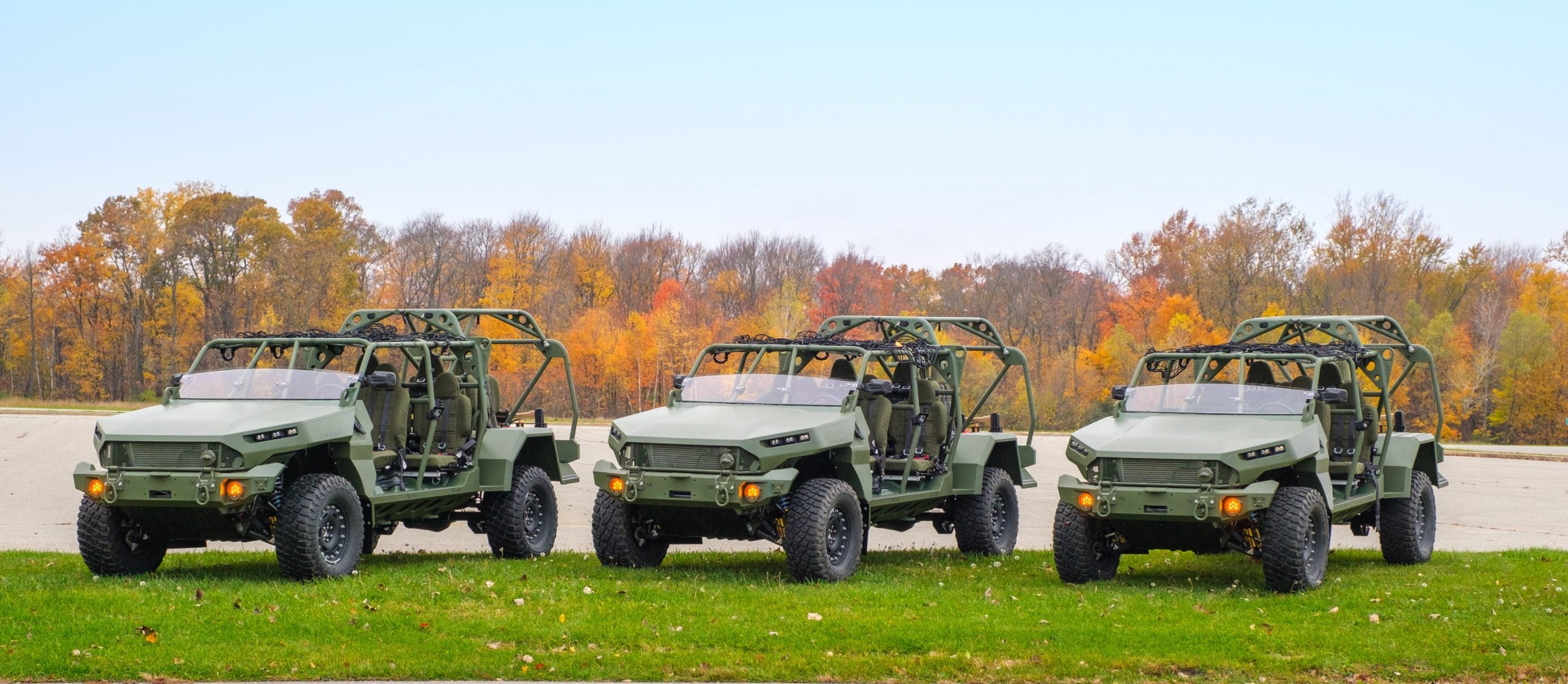
Last October General Motors (GM) Defense delivered the first Infantry Squad Vehicles (ISVs) to the US Army, only 120 days after the award of a $214.3m contract award for 649 vehicles. This marks the fist major award and delivery for the General Motors subsidiary since it was re-established by its parent company in 2017.
We caught up with GM Defense vice-president of growth and strategy Jeff Ryder to hear about the company’s plans for the future, including its interest in the recompete of the Joint Light Tactical Vehicle, leveraging commercial electric vehicle technology for defence applications, and potential new target markets.
Harry Lye: What advantages does GM Defense get from pulling commercial products into the defence market?
Jeff Ryder: The benefit of having a commercial parent company in General Motors (GM) is that GM Defense can bring proven commercial best practices, such as global manufacturing, engineering, quality, safety and advanced technologies to the defence industry.
While GM Defense will certainly answer any requirements by the US Defense Department when pursuing a contract award, we can also leverage proven commercial technology and processes based on a century of lessons learned to make a proposed vehicle even better.
The roadmap for electric vehicles and autonomy is driven by trillion-dollar markets. For many aspects of military mobility, the commercial sector has simply moved past where the defence industrial base is in terms of technology, subsystems, integrated vehicles, quality performance and manufacturing. That is what makes GM Defense a disruptor in the military mobility market. We can bring forward these advanced capabilities along with the scale of our global supply chain.
GM is a $135bn company and vehicles are our business. Now we’ve returned to building vehicles for the military, with an initial focus on integrated tactical and combat wheeled vehicles, much like the ISV. Building military vehicles from a 90% commercial baseline, like the ISV offers, is a significant head start.
How well do you really know your competitors?
Access the most comprehensive Company Profiles on the market, powered by GlobalData. Save hours of research. Gain competitive edge.

Thank you!
Your download email will arrive shortly
Not ready to buy yet? Download a free sample
We are confident about the unique quality of our Company Profiles. However, we want you to make the most beneficial decision for your business, so we offer a free sample that you can download by submitting the below form
By GlobalDataDo you see electric vehicles as a potential market for GM Defense?
GM’s CEO, Mary Barra, has laid out a company vision of zero crashes, zero emissions and zero congestion. GM is investing $27bn over the next five years towards achieving this vision, and our current annual R&D expenditures are more than the commercial R&D expenditures of the top five US defence companies combined.
We’re committed to launching 30 new electric vehicles globally by the end of 2025, two-thirds of which will be available in the US. While our vision may not directly tie to defence department requirements, those technology advancements will be available to our government and military customers.
The benefits of electrification are many. They include ‘silent drive’ in that the acoustic signature is significantly reduced, ‘silent watch’ in that the thermal signature is significantly reduced, and higher torque and acceleration, which has obvious benefits in a combat situation, not to mention reduction of toxins. Finally, the overall lifecycle economics of battery electric vehicles are better when you include performance and ease of maintenance.
We have the opportunity to drive that transformation in the military because we think of vehicle platforms as modular integrated systems where your battery electric undercarriage is applicable to multiple vehicle configurations. Approaching vehicles with a modular architecture provides optionality for customers and ties well to our commercial supply chain, with the added benefits of lower cost and proven performance.
Part of this is how we engage and inform customers about what we’re able to do for them. The military doesn’t necessarily understand the breadth of the commercial automotive industry – or in our case – specifically what GM has to offer and the capability electric vehicles can provide. GM Defense plans to lead that discussion and bring our technology into government procurement.
We’re not only looking at the defence market from the standpoint of only being a vehicle integrator, but we are also talking to other companies about how we can leverage our battery and fuel cell capabilities as a subcontractor or as propulsion integrator on their military vehicles. We’re open to that, and we’re not limiting ourselves to be a vehicle prime contractor as we create our business pipeline.
Is the US Army’s recompete contract for Joint Light Tactical Vehicle (JLTV) an opportunity GM Defense is interested in?
Yes. The army is looking for – to use their own words – a premier manufacturer. GM is synonymous with world-class manufacturing and quality, so why wouldn’t we put our best foot forward? We also believe we lead the field when it comes to world-class engineering, manufacturing, quality, safety, commercial best practices, innovation and advanced technology – that’s our legacy.
Following the success of the Infantry Squad Vehicle in the US, do you see GM Defense targeting foreign defence markets as well?
We are currently mostly focused on our US Army customer, along with other Department of Defense entities and special government customers. From a vehicle chassis standpoint, we are marketing our ability to build light tactical vehicles globally, but we’re also interested in other opportunities as a truck or a speciality vehicle provider.
With regard to the ISV, we have early-stage international opportunities, and ultimately, we absolutely want to take the ISV to the global market.
The ISV is very appealing to the global market on many different levels. The vehicle is based off of the Chevrolet Colorado ZR2 and features 90% commercial-off-the-shelf parts, including Chevrolet Performance components. While the initial design is intended to transport a nine-soldier infantry squad and their equipment, we can build variations that include less seating, add cargo storage, or adapt to add weapons mounts, and so on.
Our flexibility to build to requirements, we believe, is appealing to global markets depending on their needs and the mission they want to support.
Can you talk about the potential opportunities GM Defense is targeting in other markets?
We are pursuing speciality vehicle opportunities with civilian organisations, national security government agencies and the global market.
We are looking at border applications with off-road vehicle requirements and mission equipment, in addition to connected vehicle technology and autonomous technology. Think of the vehicles on the border; do they always need to be driven by a border agent, or could they have surveillance by vehicles that are sometimes driven and sometimes autonomous? We see a market there.
There are opportunities with the US Marine Corps, who are going through a transformation to a lighter force. They’re moving away from tanks into lighter vehicles, which is squarely in our wheelhouse.
We are performing undersea battery testing for the US Navy. This could be critical for our business because a greenlight from the navy is akin to the gold standard for safety in the military. A fire at sea is bad; a fire underwater is catastrophic. So, we’re excited about the potential to support that community with our expertise in battery electric applications.
GM has outstanding credentials in battery safety, including applications for unmanned underwater vehicles that are going to be battery-powered or potentially hydrogen fuel cell-powered. We are vertically integrated in the battery life cycle. We conduct testing at every stage of the battery cell and battery pack development, which strengthens our ability to serve the navy and other armed services.
We have a product called the Electric Ground Power Unit (eGPU), which powers flightline aircraft on the tarmac. The existing diesel equipment is inefficient, costly for operations, and requires frequent repairs. Diesel generators also emit greenhouse gases and cause noise pollution, resulting in adverse conditions for the environment and flight-line workers.
Instead of plugging a unit into a diesel generator or running the aircraft engines, you can plug it into a semi-autonomous battery pack of ours that’s quiet, clean and efficient. We are in conversations with the US Air Force about eGPU and what benefits it would bring to the flightline and will work with the other services on similar offerings. We believe there are a number of applications that leverage a mobility and battery-electric capability.
Finally, is there anything else to look out for?
During the Consumer Electronic Show at the turn of the New Year, GM’s CEO mentioned our desire to take advanced battery technology to the moon.
GM went to the moon on the Apollo programme in 1969 with the Lunar Rover, and there is an opportunity to support NASA again on the Artemis mission. NASA’s goal is permanent habitation and mobility infrastructure on the moon, and we would love to help further our nation’s goal for this generation’s lunar mobility aspirations.







